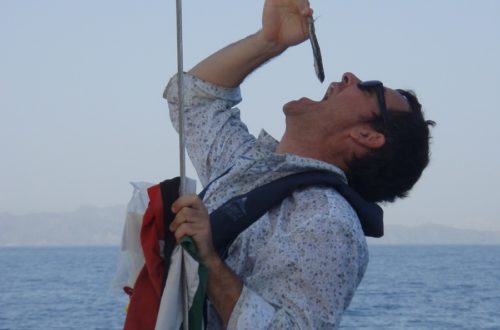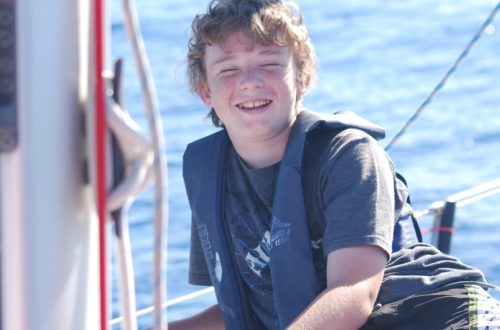
Maldives Arrival
We maintain an around the clock watch system and use a marine technology called an “Energetically Generated Gismo for Timing In Minutes Each Rotation”, otherwise known as an EGG TIMER, to remind whoever’s on the watch to periodically scan the horizon for traffic. When we get back to the real world, I’m sure we’ll all still have the urge to spring to our feet every fifteen minutes and do a quick three-sixty degree sweep of the horizon for oil tankers.
In the vastness of the Indian Ocean, there hasn’t been much shipping over the last few days – normally only one or two a day. Yesterday we came close enough to an LPG tanker to make me wonder if the “No Smoking” sign prominently painted in large letters across the superstructure was actually referring to us too. They can creep up on you in fifteen minutes. The shipping traffic of the Arabian Gulf and the Gulf of Oman are of course different stories.
Just before Ras Al Hadd a huge oil tanker was right up our chuff and closing for about an hour. When he closed to two miles, I called him on the VHF; the watch officer sounded surprised that I was concerned about his overtaking intentions and asked: “are you safe?!” I’d have felt a lot safer with a bit more water between the two of us! He passed less than a mile to our starboard; that sounds like a long way, but it’s quite daunting when we’re not even sure if these guys can see us.
The sailing is quite patchy, usually only with enough breeze for a few hours at a time. Otherwise, we motor or motor sail at low revs to conserve fuel. We are counting down the latitudes and the miles to go.
We are using more of our dried stores now. Laith made Bernard’s tea with powdered milk this morning. It was judged a success, as Bernard couldn’t tell the difference from the udder milk.
7 April 2009
I was on the sunrise night watch last night, my favourite one. The last half an hour of this shift enjoys the peaceful beauty of the sun breaking the dawn. I don’t think that the sunsets or rises we’ve seen have been especially beautiful, but I guess that you appreciate the majesty of them more out here. Part of that is the relief that the uncertainty of the night is over especially if there’s been a lot of traffic, or if the waves are big, and part of that is the feeling of being that little bit closer to nature.
The phase of the moon since we’ve left has been from the first moon to almost full moon now. It rises early in the evening and sets by about midnight. The moon-less early hours of the morning have been so dark that you can barely make out the horizon.
In the darkest hours, the stars are so pretty I’ve considered (but not been bothered) folding back the bimini sunshade to see them better. At the same time, I strangely have never really felt that far from civilisation. There are frequently aircraft high overhead (especially on the northern part of this trip), ships, and then there are the satellites. My limited understanding of the ones which are just relevant to us counts 66 orbiting the earth at any one time to keep the Iridium satellite phone connected, about 12 above the horizon at any one time to give us a GPS fix, and two separate constellations (of four and two each) should we ever need to activate the EPIRB beacon. That’s a lot of technology up there, most of which is far closer than the nearest land.
We are currently making about six knots of boat speed on my favourite point of sail, a beam reach. We now have less than 200 NM to go and are looking forward to standing on terra firma soon.
8 April 2009
Aroha is really clean now. Early this morning we took her through the Indian Ocean version of a car wash – a tropical squall. This thirty minute blast of wind up to about thirty knots and rain (lots) (no really, lots!) left her topsides squeaky clean. It’s the first squall (I’m sure of many…) that I’ve been in, so once we’d got the sails away, donned foul weather gear (the Musto gear’s great – highly recommend it) and secured loose objects (including ourselves), it was quite interesting to have a look around. The rain was intense, but quite warm. The strangest thing though was the state of the ocean. Just before the squall hit, it was fairly bumpy, as it was almost immediately afterwards. During the downpour the sea surface went quite flat with a gentle rolling surface. Apparently it’s to do with the intense pressure of the rain flattening the sea surface.
Earlier in the trip, a leaky freshwater pipe put about fifty litres of our freshwater supplies in the bilge. That accounted for about fifteen percent of our freshwater capacity and a couple of days worth of showers. The leak itself was quite easy to fix, and the water sloshing around was dully removed by sponge after it had cleaned every corner of the bilge.
And just to make this a trilogy of cleaning events, a day or two back a litre of shower gel spilt itself over the floor of the shower. It still smells like ‘Revitalizing Mandarin’ in there.
The result of these events is that now Aroha is cleaner than she’s ever been. However, the limited remaining water (and shower gel!) have resulted in three blokes who are the least clean they’ve ever been!
9 April 2009
We would have arrived in The Maldives at about 10 pm last night, but these low lying atolls aren’t worth approaching when it’s dark. In an act of irony smacking of our prayers for more wind a few days earlier, we had to slow Aroha down to arrive at daybreak the following morning.
The first sight of the northern atoll of The Maldives was a truly moving experience. As the halo of the sun arrived before the sun itself, we could make out the long low shadow of the northernmost islands. I think one’s first blue-water passage is quite an experience, and all three of us were looking forward to the exotic destination after what has felt like a long journey.
Uligamu Coastguard didn’t respond to my VHF calls (I can just imagine their voice mail message: “please only have emergencies within working hours…”), so we anchored over the word ‘anchorage’ on the chart inside the atoll off the island of Uligamu. About an hour later, four smartly uniformed officers arrived at Aroha and set about filling out pages and pages of forms. One guy checked we didn’t have firearms, the other checked for animals (I didn’t declare Laith and Bernard though they’re looking a bit wild by now), another guy immigration… and I’m not too sure what the other guy is paid to do. Maybe he just came along for some Coca-Cola and cigarettes. I’ve never sweetened officials with Marlborough Lights before, so there are lots of new experiences on this trip!
Niyaz (the immigration guy) told us we need an agent, and there’s only one approved one on the island. “How will we find him when we come ashore?” “Don’t worry, he will find you!” Sure enough, there he was waiting for us on the beach! Small town, huh!? As it turns out, Imaad (the agent guy) is Niyaz’ brother. There are only 450 people on this island so everyone’s related. We had to see the officials again in the afternoon, and by then I didn’t recognise them as they had all changed to shorts and t-shirts!
The rules and regulations here are frustrating beyond belief. They want people to come and stay in the five-star resorts, but they make life difficult for independent travel. The government has a long-standing policy of separating tourists from the locals, to ‘protect’ them from untoward influence. In turn, the locals have it pretty good – jobs for life, no tax, subsidised everything. Cruising yachts can stay for a maximum of 44 days after which they must clear out before returning to Maldivian waters. We want to stay for about 65 days, so need to find another port for an all-important clearing out certificate.
The upside of fighting through the red tape is that you can mix with locals. No tourist shops selling shark jaws or other treasures plundered from the oceans. The locals are happy to talk about their country and lifestyle, and they can provide pretty much anything at a modest markup.
Fujairah UAE to Maldives by numbers;
- Total distance: 1,535 NM (= 2,840 km)
- Total time: 13 days, 18 hours
- Average speed: 4.65 knots
- Fastest boat speed: 7.7 knots
- Slowest boat speed: Errrr… I’m pretty sure we were going backwards a few times…
- Fastest speed over ground: 10.2 knots!
- Total time under motor (including motor sailing): 7 days, 9 hours
- Average fuel consumption per hour: 1.24L/hour
- Shortest daily distance: 90.6 NM
- Longest daily distance: 138.5 NM

Follow and like us to be notified of future blogs!














